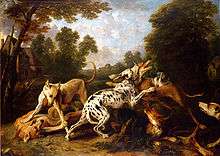Animal painter

An animal painter is an artist who specializes in or is known for their skill in the portrayal of animals, essentially up to about 1900. During the 20th century wildlife artist became a more usual term for contemporary animal painters.
Especially in the 17th century, animal painters would often collaborate with other artists, who would either paint the main subject in a historical or mythological piece, or the landscape background in a decorative one. Frans Snyders, a founder of the Baroque animal painting tradition, often provided the animals, and also still lifes of food, for Peter Paul Rubens; a different landscape specialist might provide the background. In the Dutch Golden Age such specialists tended to produce smaller genre paintings concentrating on their specialism. Animal painters came low down in the hierarchy of genres, but the best painters could make a very good living; many royal and aristocratic patrons were more interested in their subject matter than that of the more prestigious genres. Mainly in England, there were still more specialized painters from the 18th century who produced portraits of racehorses and prize specimens of livestock, whereas in France animal subjects continued to be decorative capriccios often set around garden statuary.
Animalier as a collective plural noun, or animalier bronzes is also a term in antiques for small-scale sculptures in particular, but also paintings, of animals, of which large numbers were produced, often mass-produced, in 19th century France and elsewhere. Although many earlier examples can be found, animalier sculpture became more popular, and reputable, in early 19th century Paris with the works of Antoine-Louis Barye (1795–1875), for whom the term was coined, decisively, by critics in 1831.[1][2] By the mid-century, a taste for animal subjects was very widespread among all sections of the middle-classes.
Wildlife conservation
Many modern wildlife artists or art groups hold benefits to support wildlife conservation, or participate in contests held by wildlife conservation organizations.[3]
Prominent animal painters
See also Category:Animal artists
Before 1800
- Jan Brueghel the Elder
- Giovanni Benedetto Castiglione
- Nicasius Bernaerts
- Pieter Boel
- Peter van Boucle
- David de Coninck
- Alexandre-François Desportes
- Karel Dujardin
- Jan Fyt
- Sawrey Gilpin
- Melchior d'Hondecoeter
- Jean-Baptiste Huet
- George Morland
- Jean-Baptiste Oudry
- Paulus Potter
- Roelandt Savery
- Frans Snyders
- George Stubbs
- Jacob Xavier Vermoelen
- Paul de Vos, brother of Cornelis de Vos and brother-in-law of Frans Snyders
- Jan Weenix
- Johann Wenzel Peter
After 1800
- Rosa Bonheur
- Eugène Delacroix
- John Henry Dolph
- Charles Jacque
- Edwin Landseer
- Friedrich Wilhelm Kuhnert
Modern
Forerunners of the modern style of wildlife sculpture include Rembrandt Bugatti and François Pompon. Modern wildlife art painters include John Clymer, Thierry Bisch, Kim Donaldson, Gary Hodges, Dave Merrick and Lanford Monroe.
Gallery
-

Dogs fighting by Frans Snyders, who probably left the landscape background to another kind of specialist.
-

A life-size portrait of the racehorse Whistlejacket, by George Stubbs. According to legend, painted from the life in the stables, despite the subject's attempts to attack his new rival.
-

Common foxes in the snow by Friedrich Wilhelm Kuhnert.
References
- ↑ "Animalier sculpture." The Concise Grove Dictionary of Art. Oxford University Press, Inc., 2002. Answers.com 13 Apr. 2008.
- ↑ Dr. Arthur R. Metz and His Collection
- ↑ "About the AFC". Artists for Conservation. Retrieved 9 July 2016.
| Wikimedia Commons has media related to Paintings of animals. |
